Located about 60 km northwest of Chengdu, the Dujiangyan Irrigation System is the world’s oldest and still functioning dam-free water diversion project, dating back to the Qin Dynasty. This remarkable hydraulic engineering marvel has been irrigating the Chengdu Plain’s 5,300 square kilometers of fertile land and supplying water to over 50 cities and towns in Sichuan for more than two millennia. Visitors can experience firsthand at the extraordinary wisdom and legacy of the Qin Dynasty people from over 2,000 years ago.
Dujiangyan Irrigation System Facts
- Type: National Parks, Bodies of Water
- Address: On the Minjiang River at the west of Dujiangyan, Dujiangyan 611830 China
- Recommended Visiting Time: 3-4 hours
- Opening Hours: 08:00 – 18:00
- Tickets: CNY 80. Book Now →
History of Dujiangyan Irrigation System
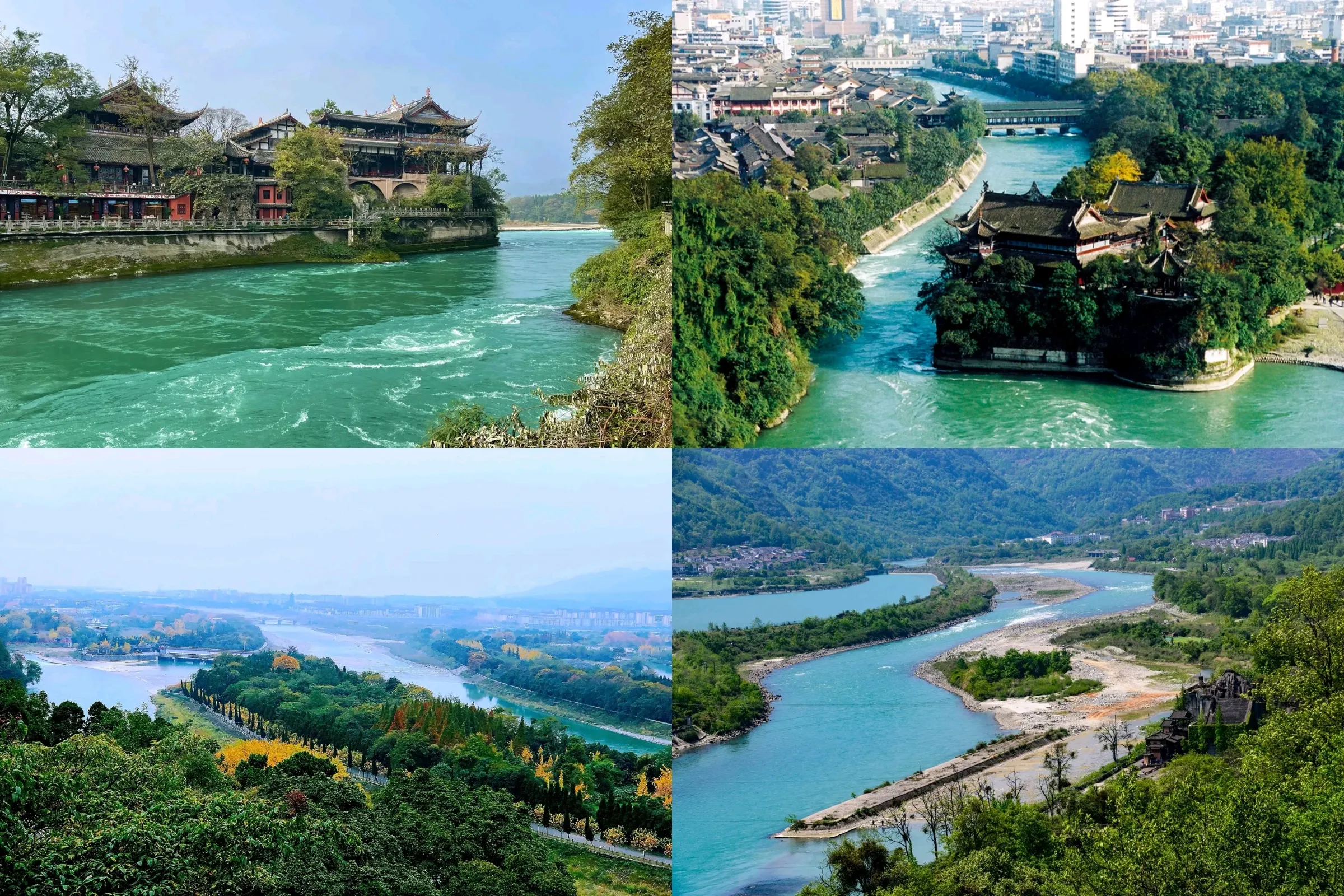
The Dujiangyan Irrigation System, built in 256 BC, stands as an outstanding exemplar of ancient Chinese hydraulic engineering. Confronted with the Minjiang River’s frequent flooding, Li Bing, a local official of Sichuan Province at that time, along with his son, led residents in creating this innovative water conservancy project based on thorough field surveys.
This engineering marvel transformed the Chengdu Plain completely. What was once a flood-prone region became the fertile “Land of Abundance,” ensuring agricultural stability while providing crucial material support for the Qin state’s eventual unification of China. Historical records indicate that crop yields increased significantly after Dujiangyan’s completion, substantially bolstering Qin’s military campaigns.
Remarkably, after weathering 2,200 years of natural elements, Dujiangyan continues functioning effectively today. Even during the devastating 2008 Wenchuan earthquake, the ancient structure remained largely intact, still irrigating over 1,000 square kilometers of farmland across more than 30 counties. In 2000, UNESCO recognized Dujiangyan as a World Heritage Site, celebrating it as a masterpiece of ancient Chinese engineering wisdom.
How does the Dujiangyan Irrigation System Work?
The Dujiangyan Irrigation System operates through three core components working in perfect harmony: Yuzui, Baopingkou and Feishayan. This ingenious system harnesses natural topography and hydraulic principles to simultaneously achieve flood control, silt drainage, and precision irrigation without dams—a masterpiece of ancient hydro-engineering that resolved the fundamental conflict between flood prevention and water supply.
Yuzui (Fish Mouth Levee)
This V-shaped dividing dike automatically splits the river’s flow between the flood-diverting Outer Channel and the irrigation-focused Inner Channel, with natural adjustments for seasonal water variations.
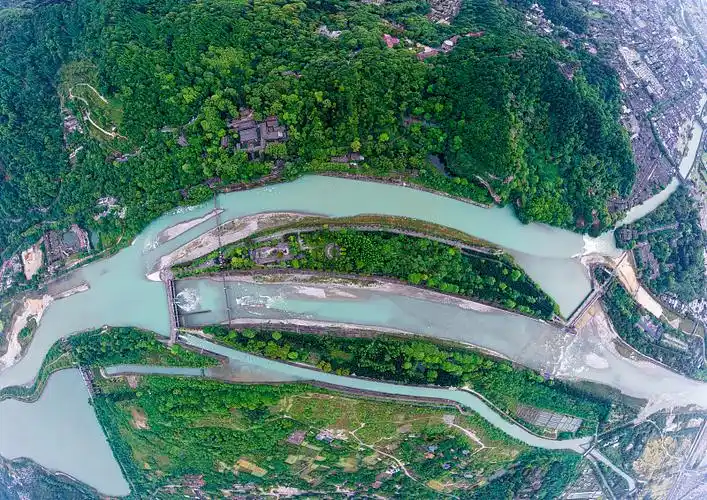
Feishayan (Flying Sand Weir)
An angled spillway that automatically discharges excess floodwater while using swirling currents to remove sediments, keeping the system clear.
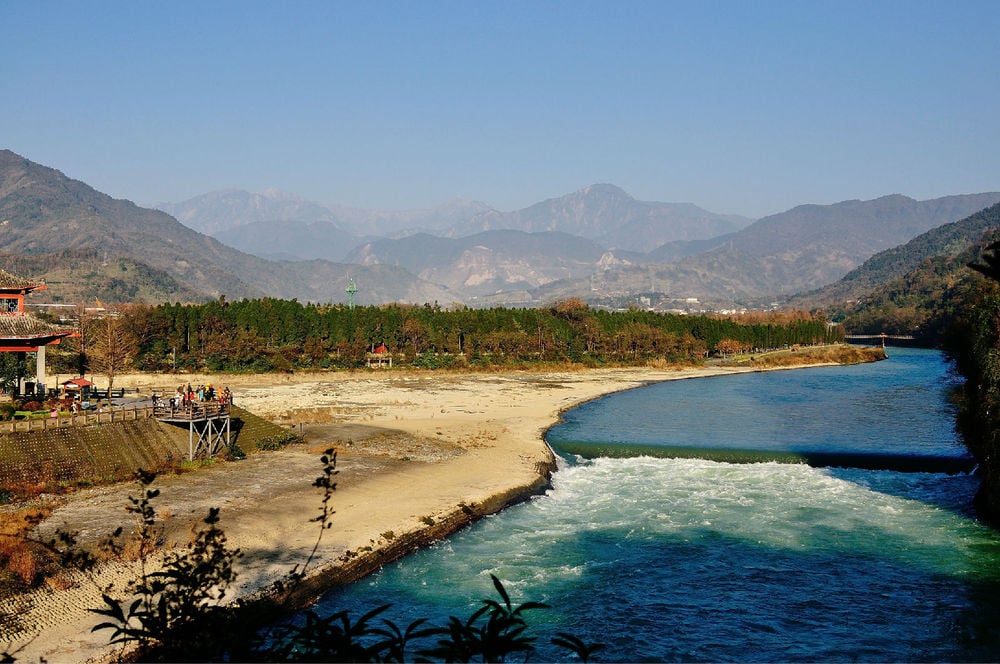
Baopingkou (Bottle-Neck Channel)
A carefully proportioned artificial gorge that naturally regulates water intake, maintaining steady flow while filtering out debris.

Main Attractions in Dujiangyan Scenic Area
Erwang Temple
Perched on Minjiang River’s right bank, Erwang Temple is a Qing-dynasty complex honoring Li Bing and his son. The 50,000㎡ site features a solemn temple quarter in the west and a landscaped garden area in the east. The Grand Hall houses vividly painted statues of the legendary duo, with ancient hydraulic principles carved into stone walls. For visitors, the temple’s elevated vantage point offers more than just architectural appreciation; it serves as the perfect observation deck to contemplate the entire Dujiangyan system. Erwang Temple has sustained 2,200 years of continuous worship, hosting the annual Qingming Water-Releasing Festival and the late-June temple fair commemorating the birth anniversaries of Li Bing (June 26) and his son (June 24).
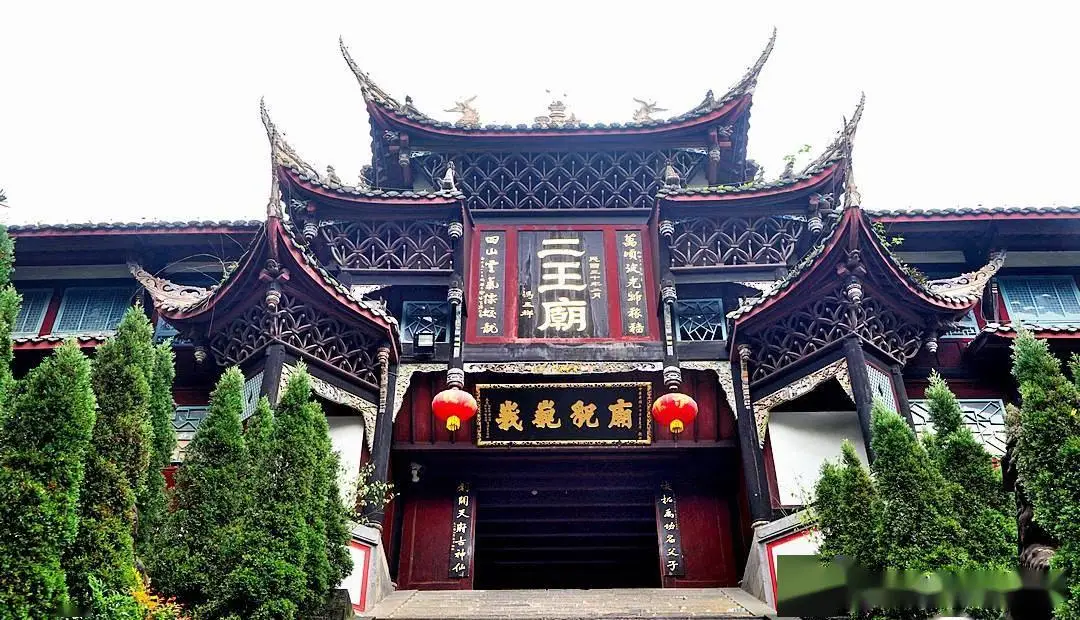
Fulong Temple
Located in Lidui Park, Fulong Temple dates back to the Jin Dynasty (265-420 AD). Originally honoring Taoist master Fan Changsheng, it later became a memorial site for Li Bing. Steeped in legend, the site is believed to be where the deity Erlang subdued a flood dragon, imprisoned beneath Lidui in a deep pool, inspiring the poetic scene “Frozen Pool Cradles a Dragon” among the region’s Ten Classic Views.
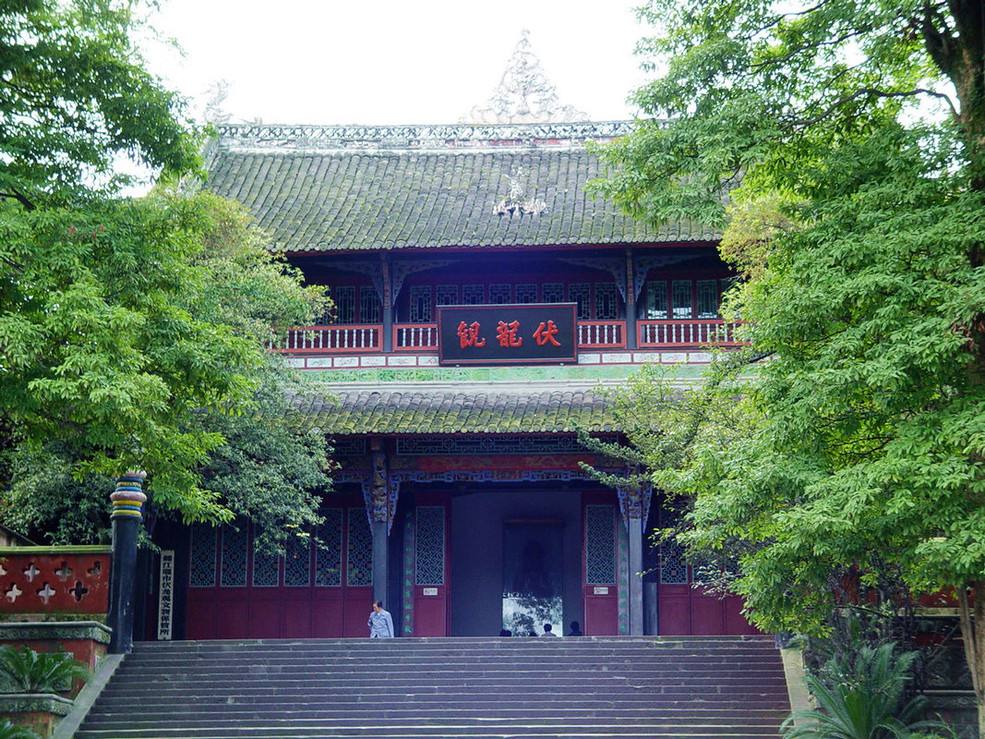
Yulei Mountain
East of Erwang Temple, Yulei Mountain forms an integral part of the Dujiangyan scenic area. Its slopes are blanketed with ancient trees shading a preserved section of Ming-era fortifications, where locals practice morning exercises. The summit’s Yulei Pavilion, a classically styled observation deck, rewards visitors with panoramic views of the ancient irrigation system and, on clear days, distant cityscapes.
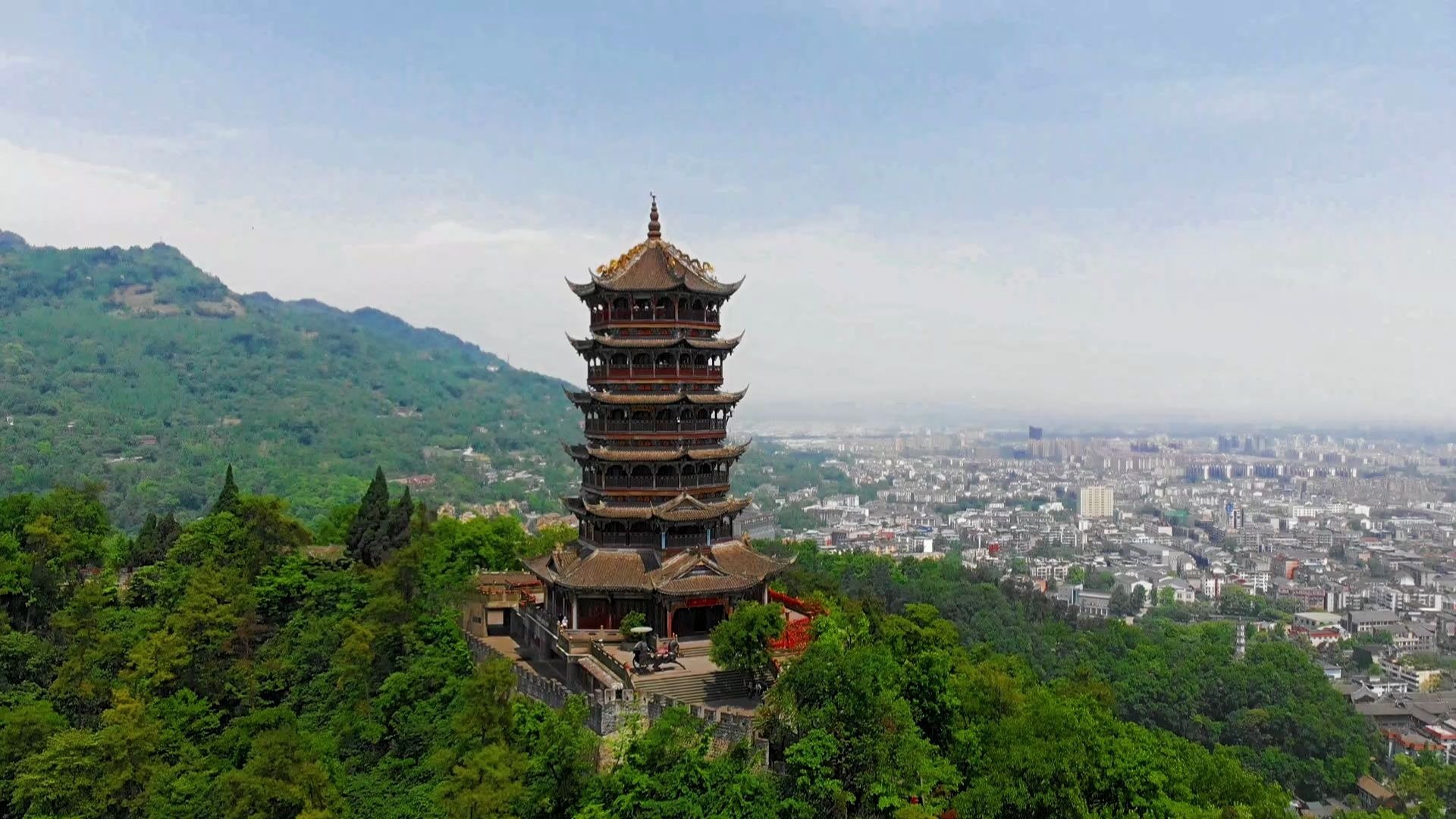
Anlan Suspension Bridge
Spanning the Inner and Outer Rivers at Dujiangyan’s Yuzui division point, Anlan Suspension Bridge stands as the only well-preserved ancient cable bridge in the upper Minjiang region. Dating back to pre-Song Dynasty (before 960 AD) with its current structure rebuilt in 1974, this “Top Five Ancient Bridge of China” offers visitors a thrilling walk with its characteristic swaying motion, while providing iconic photographic backdrops – though caution with cameras is advised on the moving walkway.
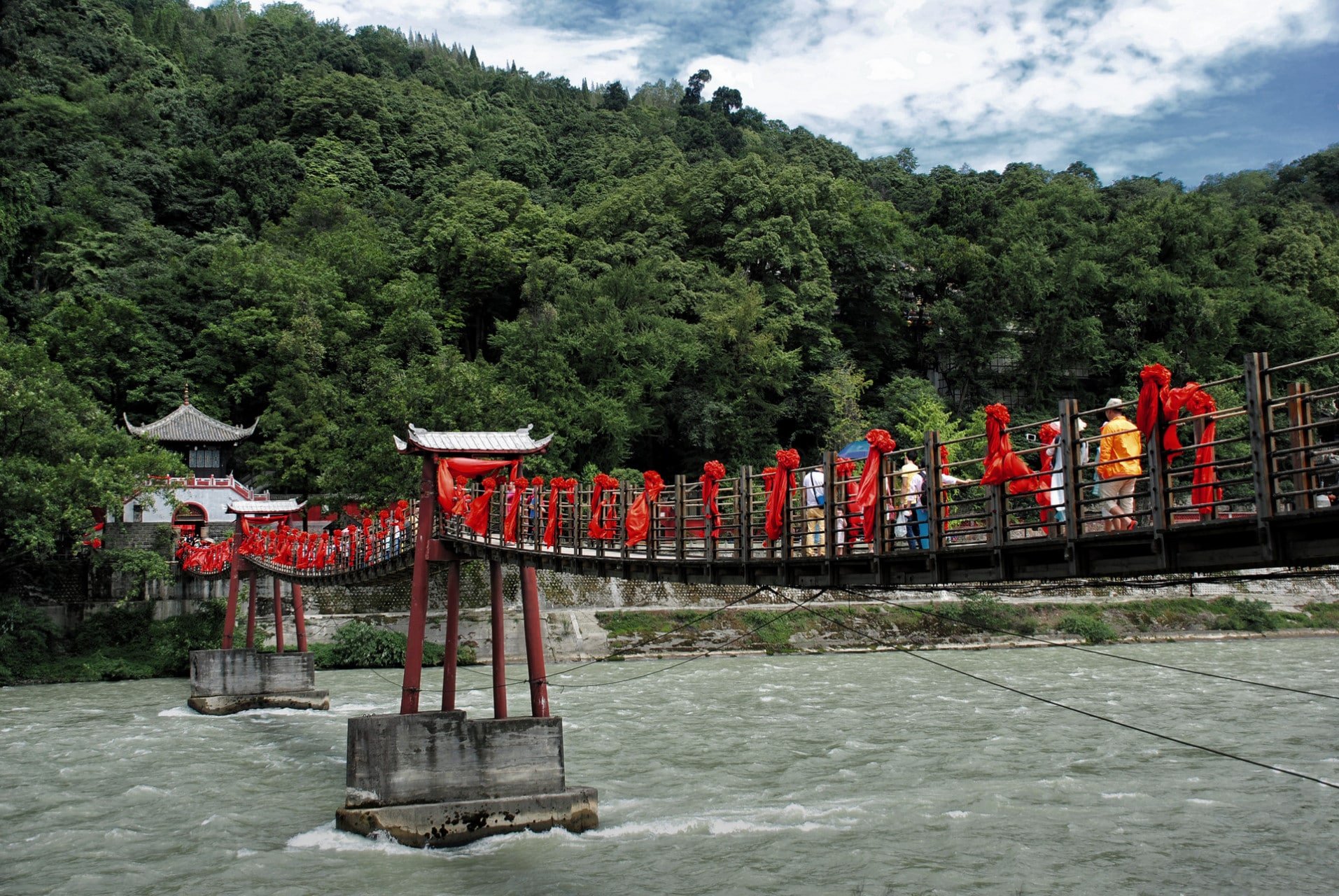
Recommended Tour Routes in Dujiangyan
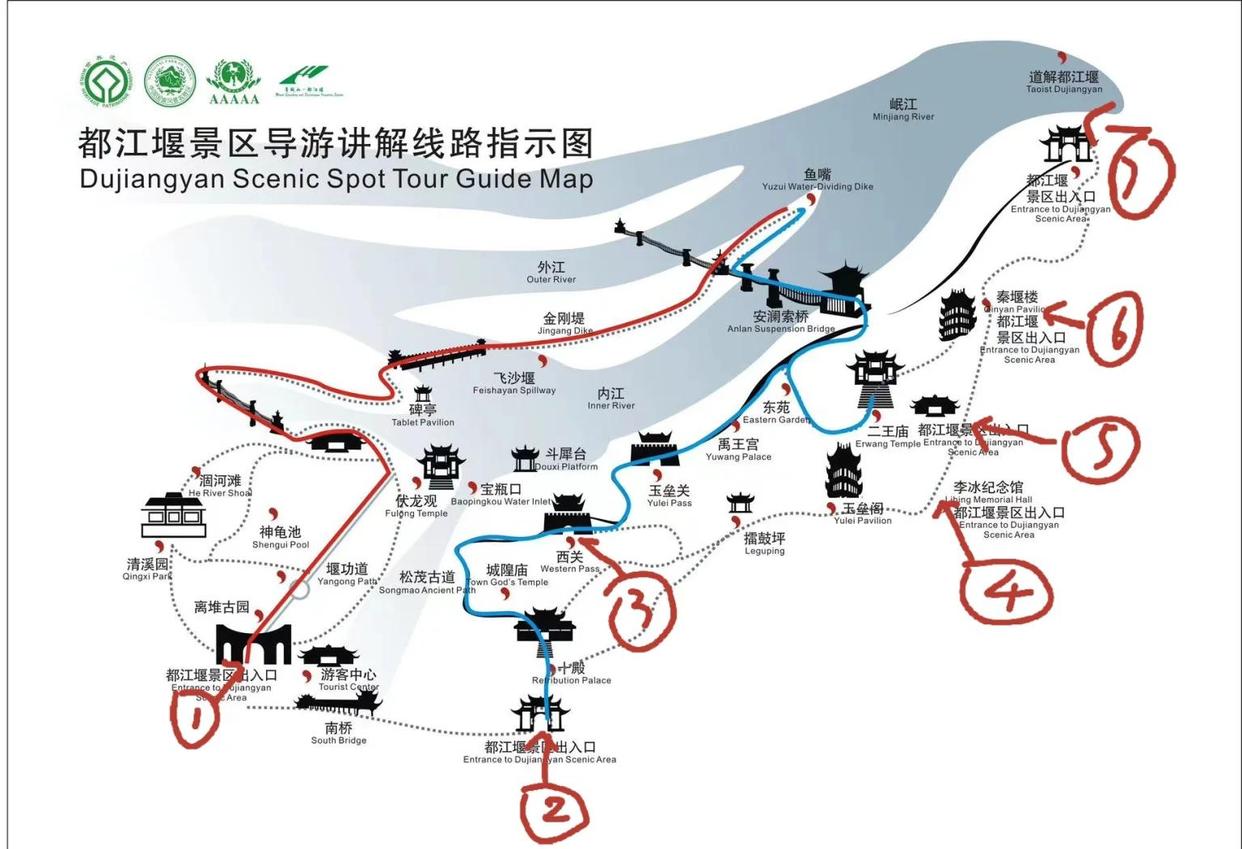
Classic Route (2.5 hours)
Enter through Qinyan Tower (Gate 6) → Erwang Temple → Anlan Suspension Bridge → Yuzui (Fish Mouth) → Feishayan Spillway → Baopingkou → Fulong Temple → Exit at Lidui Park South Gate.
Highlights: This route eliminates mountain climbing—enjoy a panoramic view first, then descend for the perfect photo at Anlan Suspension Bridge. Ideal for visitors with average physical stamina.
In-Depth Hiking Route (3.5-4 hours)
Start at Gate 1 (Lidui Park) → Fulong Temple → Baopingkou → Feishayan Spillway → Yuzui (Fish Mouth) → Anlan Suspension Bridge → Erwang Temple → Songmao Ancient Road (Tea-Horse Road) → Yulei Pass → Yulei Pavilion → Western Pass → Nanqiao Bridge
Highlights: Summit climb to Yulei Pavilion for breathtaking Dujiangyan views and Trek the historic stone-paved Tea-Horse Road section. Hike downhill toward Xiguan to explore Guanxian Ancient TownRecommended for experienced hikers and photography enthusiasts.
Pro Tip: Time your arrival at Nanqiao Bridge by 6:15 PM to secure the best viewing spot for the Blue Tears show.
Best Time to Visit Dujiangyan Irrigation System
The ideal seasons are spring (March-May) and autumn (September-November), when mild weather (15-25°C) creates perfect conditions for exploring. These periods offer comfortable temperatures, clear skies, and seasonal highlights like April’s Water-Releasing Festival or autumn’s golden landscapes.
Avoid summer’s heavy rains and winter’s chill, and consider visiting on weekdays to escape the crowds that flock here during weekends and Chinese holidays like October’s Golden Week.
Dining & Accommodation Tips
When visiting Dujiangyan, don’t miss the local flavors at Zhongyazi, a renowned establishment in Guanxian Ancient Town celebrated for its crispy sweet duck and spicy duck feet, or sample traditional snacks like brown sugar rice balls and leaf-wrapped rice cakes at Lao Hao Luo Ji. For evening eats, the lively Nanqiao Night Market offers delicious street food by the Min River, including spicy hotpot and refreshing icy desserts.

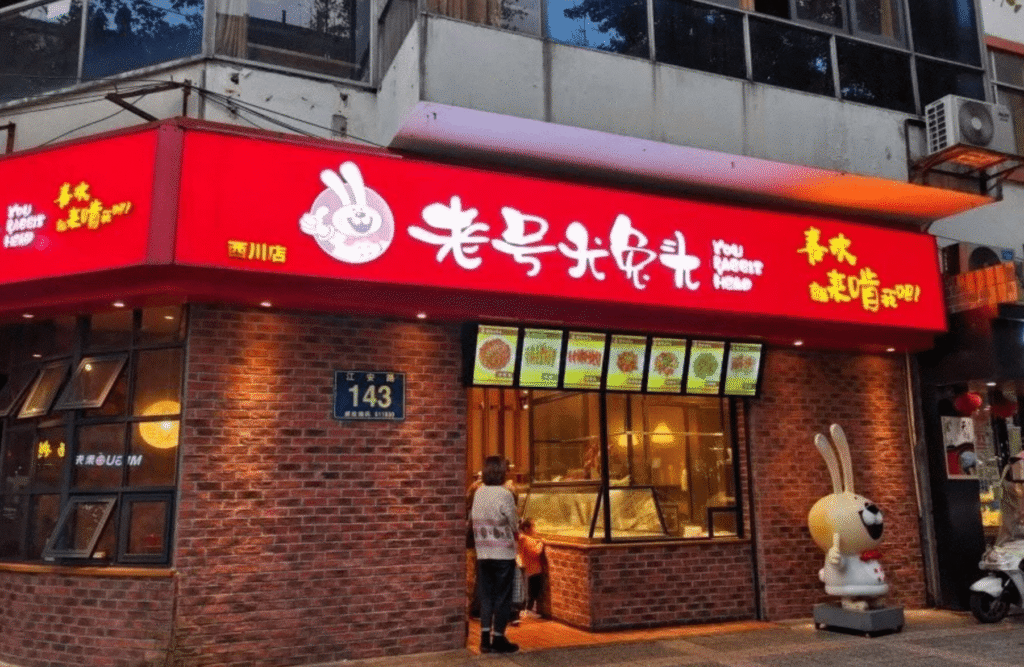
For your stay, we recommend checking trip.com for highly-rated hotels near the scenic area that combine convenient location with excellent guest reviews and amenities.
How to get to Dujiangyan Irrigation System
From Chengdu Downtown
- Take the Chengdu metro line 2 to Xipu Railway Station. Then transfer to a high-speed train to either Dujiangyan Station (20-30 minutes, ¥10). From Dujiangyan Station, take bus line 4 or 9 directly to the scenic area (45 minutes, ¥2).
- For direct access to Dujiangyan Scenic Area, tourist shuttle buses are available from multiple locations across Chengdu including Wuhou Temple, Jinli, Wide and Narrow Alley. These comfortable shuttles offer a convenient journey taking 70-150 minutes with fares ranging from ¥29-39.
From Chengdu Shuangliu International Airport
- From Chengdu Shuangliu International Airport, you can take a direct bus to Dujiangyan Passenger Transport Center (approximately 95 minutes). Upon arrival at the bus station, transfer to local bus route 7 heading to Dujiangyan Middle School (about 6 minutes ride). The scenic area entrance is within easy walking distance from the bus stop.
- Take the Shuangliu Airport shuttle bus to Xipu Station, then transfer to the intercity train to Dujiangyan Station, and finally take either bus No. 4 or 9 to reach your destination.
Tickets & Opening Hours
Get Your discount Tickets Now| Entrance Fee | Entrance ticket: CNY 80 Free for children under 6 or under 1.2 meters Free for seniors over 65 years old |
| Sight-seeing bus | CNY 15 (round-trip) and CNY 10 (single trip) |
| Opening Hours | March 2 to November 30: 08:00 – 18:00 December 1 to next March 1: 08:00 – 17:30 |
Dujiangyan Irrigation System Nearby Attractions
Dujiangyan Panda Base
Dujiangyan Panda Valley, located in Dujiangyan City, Chengdu, is a scenic area that combines natural landscapes, wildlife conservation, and educational tourism. The valley is home to not only giant pandas but also various rare animals such as golden snub-nosed monkeys and red pandas, offering visitors the opportunity to observe a variety of adorable creatures.
Mount Qingcheng
Mount Qingcheng is one of the Four Sacred Taoist Mountains in China and one of the birthplaces of Taoism. Together with the Dujiangyan Irrigation System, it is listed as a UNESCO World Heritage Site. With its unique natural scenery and profound Taoist cultural heritage, it attracts countless visitors to explore.